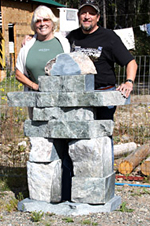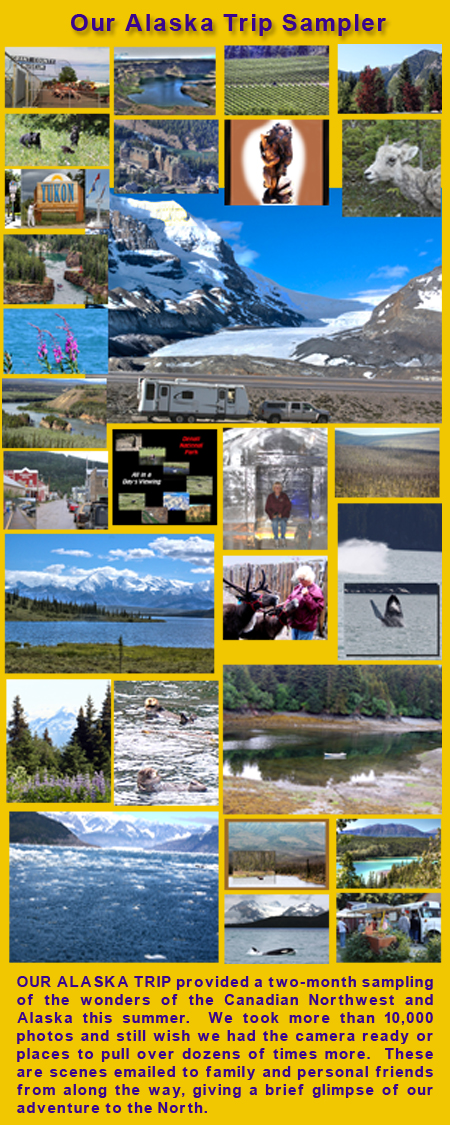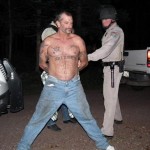This is the second part of a two-part article, No. 32 in a continuing series about our trip through Canada to Alaska
CB Radio – Since caravans require having a CB radio to communicate with the staff and other rigs while on the road, on my son’s advice we got a powerful CB radio with a faceplate loaded with knobs and toggles. That gave us more opportunities to accidentally hit or turn the wrong feature, … opportunities we took! Suggestion 1) Get a good CB radio, but if you’re not familiar with them, don’t go overboard with features. And 2) ask advice on which antenna to buy and where to put it on your truck or rig. It makes a difference in reception, particularly, for us, when you’re trying to talk with a caravan member located behind the trailer.
Speed Limits – I mentioned earlier that I taped a chart on my steering wheel to convert mph to kph. We’re still in Canada and I’m still referring to it often. An inconvenience is that Canadian roads don’t have “Resume Speed” signs, so it’s not obvious when you can legally get back to 90 or 100 kph. And it gets tricky in towns posted at 40 which have a stretch of unpopulated areas and then you realize you’re still in town where 90 could get you a hefty ticket. Also, when a road sign before a curve says “SLOW,” it’s a good idea to slow down.
Sales Tax – The merchants often explain, “The ministry wants its share” when adding the sales tax. In Alaska, there is no sales tax – except in a few towns. It’s a good idea to ask before buying. By the way, the State of Alaska has about eight “boroughs,” comparable to counties, and the rest of the state in the Interior is mainly U.S. Government lands.
Carrying Cash – There was a question in the last comments section about having enough cash with you for the trip. First, Visa & MasterCard credit cards are accepted just about everywhere, but we did run into a couple of times when the local electricity wasn’t working – a minor inconvenience that can be overcome with cash. Another reason to get cash at banks or money exchanges along the way is that when you’re in Canada, you do better using Canadian currency. When in Alaska, you’re better off with Uncle Sam’s greenbacks. It’s a good idea to check with your bank about extra charges for using your plastic in Canada.
Brochures – Monique is an avid brochure reader, which often results in our finding places and attractions that are off the beaten path or that explain why a place we wouldn’t consider visiting could be the highlight of our week. There are lots of free brochures and tourist books everywhere, so it’s advantageous take some time to skim through them.
We had our photo taken at Mile 0 of U.S. Hwy. 1 in Key West and Mile 0 of the Alaskan Highway in Dawson Creek. I asked two Park Service rangers where Mile 0 is in Skagway, which is the end of the road. Neither knew, but one mentioned there is the Mile 0 B&B in town. When I replied that that’s closer to Mile 1 than the end of the road, he opined that Skagway is a town of hoaxes, trickery and a take-advantage-of-you attitudes, which could be why they named the B&B Mile 0. Good answer!
Inukshuks – In my article listing handy definition you should know, one important omission was the “Inukshuk” (another spelling might be “inuksuk”). Monique adopted a couple of them for our trailer and we had  pictures taken with others. The First People’s “Inukshuk” is a statue built of stones that, depending on the person giving you its history, is either, 1) to point the way from one place to another by: A) looking in the direction of its arms or B) by looking between the legs, or 2) a marker of a spot, like where to find the best caribou, or 3) since it is in the form of a man, it was to scare away critters. Take your pick.
pictures taken with others. The First People’s “Inukshuk” is a statue built of stones that, depending on the person giving you its history, is either, 1) to point the way from one place to another by: A) looking in the direction of its arms or B) by looking between the legs, or 2) a marker of a spot, like where to find the best caribou, or 3) since it is in the form of a man, it was to scare away critters. Take your pick.
We crossed over from British Columbia to Washington, camping in the Mt. Baker-Snoqualmie National Forest, enjoying an aqua-water riverside campsite just down the road from Mt. Baker with views of several of the most scenic mountains in the U.S.
And with that I wind up the series on “Our Trip to Alaska.” BUT, one final thought about visiting Alaska by RV. For only a very few independent spirits, Alaska is not a destination, but rather a journey. The absolutely unforgettable adventures encountered while driving through Western Canada with all the wonders of nature surrounding you and of wrapping yourself in the widely varied experiences of Alaska is what it was all about, at least for us. In our opinion, this is the ultimate RVing experience of North America.
I have more articles in mind relevant to RVing, including memorable travel experiences, past and future, so stay tuned.
From the “Never-Bored RVers.” We’ll see you on down the road.


Delos Cloud
Thanks for a great series. I probably missed it but was diesel available throughout Alaska and Canada on your trip? We are several years away from an opportunity to spend this much time on the road but greatly looking forward to seeing Alaska and everything in between from our RV.
Thanks,
Delos Cloud
Alexandria, VA
Jim & Lyne' Ward
Jim and I have been following your travels.. Great information.. He so much wants to go maybe next year or the year after that..
We loved being able to travel with you..
Thank you so much,
Jim and Lyne’ Ward
Dean Riley
We missed nearly all your Alaska posts. Is there a way this can be obtained in toto?
Richard Gregorie
Wow! We have just started rving and your series was terrific. It will be a while before we will make such a venture, but you have given us something to look forward to. Thanks so much for taking the time to bring your great adventure into the homes of others who may not be able to go to Alaska but live through your experiences.
God Bless and safe travel…………..Richard
Frank
Thank you for this wonderful series on your adventure! I looked forward to reading each article.
Now, if I ONLY had enough vacation & money to take a trip like yours myself……………………..:(
Chuck Sanford
Do you have a link that has the first 10 entries of your trip experience?
My wife and I have greatly enjoyed three 3 week vacations in Alaska. Next summer we will be drive our motor home & Outback to Alaska. We are looking forward to the journey through B.C. and the Yukon. Thanks again for sharing your experiences.
jim
enjoyed ur trip and the way u discribed it.
on the CB, a DC grounded antenna will give u less noise.
Sucie
What kind of trailer do you have and do you fulltime in it?
butterbean carpenter
Howdy yall,
THANK YOU, FOR THE WONDERFUL TRIP!!!! I’ll never have that opportunity so
I’ very glad yall took me along with you… I’m a 75 year old crippled up rancher,but
I love to go on trips, such as this.. I have a high school buddy who lives in Alaska
and has asked me many times to come up there… I just never could make it until I went with yall… Thanx
butterbean carpenter
RunningStar Ranch
Coleman county
Texas
robert
Thank you Barry and Monique for sharing your experiences with us; you have givien us one more place to visit. We have travelled from St. John’s, Newfoundland to Tofino on Vancouver Island and from Labrador to Virginia. Unfortunately we have been limited to trips of 3 or 4 weeks because of our careers and are looking forward to the time we can really cut the ties – about three years. We are happy that you have enjoyed our country and hope that you can visit again. From the most easterly point of our continent (Cape Spear in Newfoundland) to Tofino there is a lot to see. If you enjoyed British Columbia you will really enjoy the rugged terrain and extremely hospitable folks in Newfoundland. It is great that our countries are such good neighbors. See you on the road and we look forward to your future posts.
Old Gray
I agree with GK, above, who suggests that he has the same problem in the lower 48 that you had in parts of Canada or the north – no signs to inform drivers when they can resume the higher speed. Our trip from the Grand Canyon this spring had us driving more slowly than most of the traffic after nearly every town since we had no idea whether or not the higher limit had resumed – or a speed trap was awaiting us. On Ontario highways, wherever the speed limit changes, a “Begins” sign is fastened to the bottom of the speed limit sign so we know when we can resume.
All this when I could just have said, “Thanks for the wonderful tale of discovery you have shared with us. We have enjoyed every bit of it along with you. We are looking forward to reading more of your writing as you continue your travels.”
Ron Olsen
The end of the AlCan is not in Skagway if that is what you were looking for. The End is in Delta Junction. Before you reach Fairbanks. Ron
Lynne Schlumpf
Thanks, once again, for making Alaska known to the rest of the U.S. So many times we are told, when trying to talk to someone from the Lower 48 on the phone, that “our services/products are not available to foreign countries.” We smile and remind them politely that we are a part of the U.S. – the 49th state and proud of it. And we are very different. The people are different and tough and I respect them very much for what they tolerate and how strong they are. Thanks again for showing us how fantastic Canada really is, as well… Eh?
bbwolfe
Barry, Monique, we are just down from you in Maple Valley, Washington. If your looking for a place to rest up while in town, drop me a line: [email protected]
Peggy
Thank you for all the work you’ve done in keeping everyone posted as to your travels; what you’ve seen; etc, etc… I, for one, really appreciated it as I know the work involved and the joy of riding throughout Canada into Alaska…
Yes, I agree, it’s a must see – it certainly is a journey almost into another world but still an important part of the USA…
Again, thank you…
cubbear
Gary
Sorry about the typo. Clicked just as I read my response. Hand was quicker than the eye.
Gary
Thanks for all your efforts to keeping us inform about the fun and the hardships of travel beyond the normal. Well written and good pix too. Thanks again. G&R Case
GK
On speed limits in Canada: instead of using a “Resume Speed” sign, most Canadian provinces put a speed limit sign at the point where the speed limit changes back, since the speed limit prior to a section may different than the one after it. This is true for Alberta, Saskatchewan, Manitoba, Ontario and British Columbia. There are times where the speed limit sign is pretty far away from where you might expect it to be. Each province, county/MD, city and town has different rules on where/how they do it, and sometimes they don’t seem very well thought out. But there always is one as far as I can remember in the past 30 years of driving (yup, I’m still a “youngster”).
I have to admit that I don’t recall seeing very many “Resume Speed” signs in the US, but I’ve only driven in about half of the the lower 48. I do generally remember seeing speed limit signs at the point where the limit would change back, though.
I had the “benefit” of learning to drive a few years after we switched to metric, so my first beaters had mph. I’ve memorized the most common conversions (50km/h=30mph, 60km/h=35mph, 90km/h=55mph, 160km/h=a chat with a judge 🙂 ), and can do the rest in my head if need be. The coolest solution in a car was a Chevy Malibu I rented once to drive from Calgary down through the US: there was a setting to make everything metric or imperial (speedo, odometer, temperature). It was cool to watch the speedo needle move on its own when you switched it while driving. The mph or km/h would illuminate on the instrument panel to let you know which units you were in. Brilliant idea. No need to squint and make out the (sometimes incorrect) smaller markings of the alternate system.